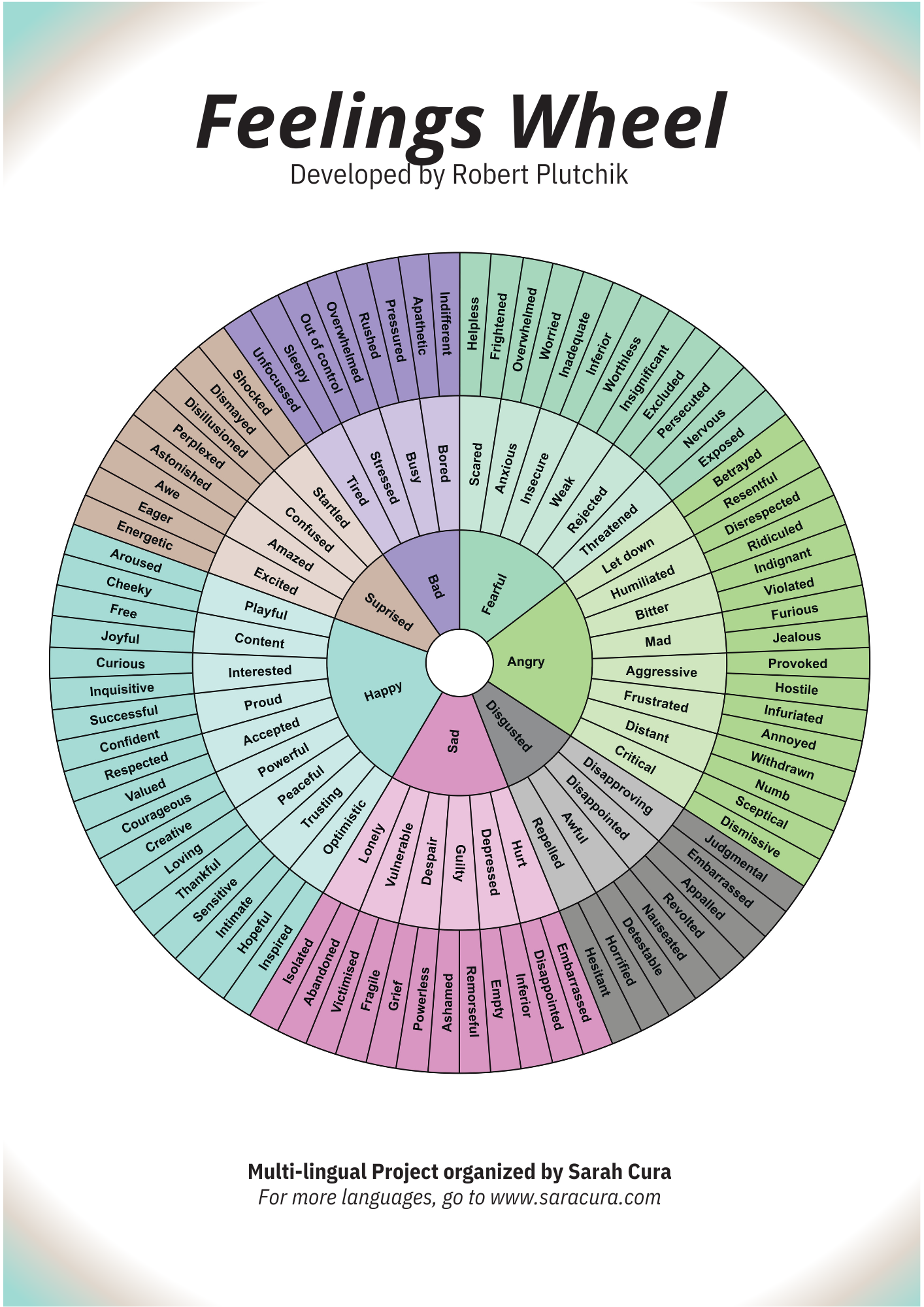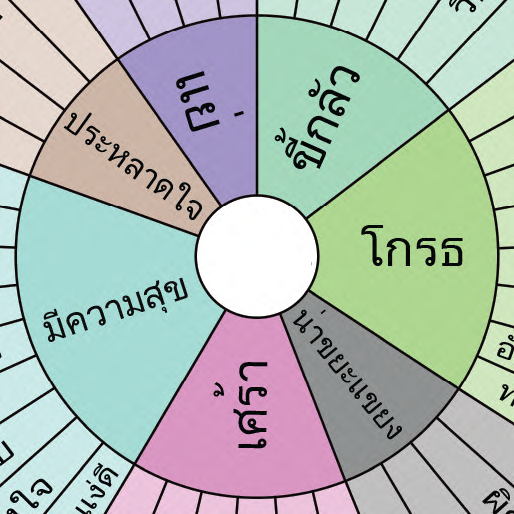 Image 1 of 3
Image 1 of 3

 Image 2 of 3
Image 2 of 3

 Image 3 of 3
Image 3 of 3




Japanese Feeling Wheel - A4 Size | Emotions Chart | Therapy, Classroom SEL, Parenting Tool
Japanese Emotion Wheel: Your Compass for Naming and Navigating Feelings
Here is the Feeling Wheel, created by Robert Plutchik, translated into Japanese. This is a downloadable, printable, full-page version of the wheel, available in A4 and Letter size. To download the Letter size, click here.
For a Poster of this Feeling Wheel, click here.
Struggling to put your feelings into words? Emotions are powerful, but often hard to describe. The Emotion Compass (also known as the Feeling Wheel) gives you a clear, visual way to name, understand, and express your emotions.
Translated into many different languages, this tool is designed for:
· Therapists & Counselors – help clients put words to their emotions
· Educators & Parents – support children’s emotional learning (SEL)
· Multilingual Families & Communities – build a shared language of emotions
· Workplaces & Coaches – encourage open, clear communication
· Individuals – deepen mindfulness, journaling, and self-reflection
When we can name our emotions, we can manage them better, communicate more clearly, and connect more deeply with others. The Emotion Compass makes emotional literacy accessible across cultures and languages.
✔ Available in over 15 languages now
✔ Perfect for therapy, classrooms, self-care, parenting, and language learning
✔ A beautiful, easy-to-use chart that makes emotions clear and accessible
✔ Posters in many sizes also available (see other listings)
By turning vague feelings like “bad” or “fine” into specific emotions (like “frustrated” or “hopeful”), the Emotion Compass helps you build emotional intelligence, better communication, and self-awareness.
Use it with your kids, your clients, your students—or keep one by your desk for daily reflection.
✨ Great gift for therapists, teachers, parents, and anyone exploring mindfulness or self-growth.
Other Feeling Wheels available:
Arabic Feeling Wheel - Letter Size
Arabic Feeling Wheel - A4 Size
Chinese Feeling Wheel - Letter Size
Chinese Feeling Wheel - A4 Size
French Feeling Wheel -Letter Size
French Feeling Wheel - A4 Size
German Feeling Wheel - Letter Size
German Feeling Wheel - A4 Size
Hebrew Feeling Wheel - Letter Size
Hebrew Feeling Wheel - A4 Size
Hindi Feeling Wheel - Letter Size
Hindi Feeling Wheel - A4 Size
Italian Feeling Wheel - Letter Size
Italian Feeling Wheel - A4 Size
Japanese Feeling Wheel - Letter Size
Japanese Feeling Wheel - A4 Size
Korean Feeling Wheel - Letter Size
Korean Feeling Wheel - A4 Size
Polish Feeling Wheel - Letter Size
Polish Feeling Wheel - A4 Size
Portuguese Feeling Wheel - Letter Size
Portuguese Feeling Wheel - A4 Size
Russian Feeling Wheel - Letter Size
Russian Feeling Wheel - A4 Size
Spanish Feeling Wheel - Letter Size
Spanish Feeling Wheel - A4 Size
Turkish Feeling Wheel - Letter Size
Turkish Feeling Wheel - A4 Size
Japanese Emotion Wheel: Your Compass for Naming and Navigating Feelings
Here is the Feeling Wheel, created by Robert Plutchik, translated into Japanese. This is a downloadable, printable, full-page version of the wheel, available in A4 and Letter size. To download the Letter size, click here.
For a Poster of this Feeling Wheel, click here.
Struggling to put your feelings into words? Emotions are powerful, but often hard to describe. The Emotion Compass (also known as the Feeling Wheel) gives you a clear, visual way to name, understand, and express your emotions.
Translated into many different languages, this tool is designed for:
· Therapists & Counselors – help clients put words to their emotions
· Educators & Parents – support children’s emotional learning (SEL)
· Multilingual Families & Communities – build a shared language of emotions
· Workplaces & Coaches – encourage open, clear communication
· Individuals – deepen mindfulness, journaling, and self-reflection
When we can name our emotions, we can manage them better, communicate more clearly, and connect more deeply with others. The Emotion Compass makes emotional literacy accessible across cultures and languages.
✔ Available in over 15 languages now
✔ Perfect for therapy, classrooms, self-care, parenting, and language learning
✔ A beautiful, easy-to-use chart that makes emotions clear and accessible
✔ Posters in many sizes also available (see other listings)
By turning vague feelings like “bad” or “fine” into specific emotions (like “frustrated” or “hopeful”), the Emotion Compass helps you build emotional intelligence, better communication, and self-awareness.
Use it with your kids, your clients, your students—or keep one by your desk for daily reflection.
✨ Great gift for therapists, teachers, parents, and anyone exploring mindfulness or self-growth.
Other Feeling Wheels available:
Arabic Feeling Wheel - Letter Size
Arabic Feeling Wheel - A4 Size
Chinese Feeling Wheel - Letter Size
Chinese Feeling Wheel - A4 Size
French Feeling Wheel -Letter Size
French Feeling Wheel - A4 Size
German Feeling Wheel - Letter Size
German Feeling Wheel - A4 Size
Hebrew Feeling Wheel - Letter Size
Hebrew Feeling Wheel - A4 Size
Hindi Feeling Wheel - Letter Size
Hindi Feeling Wheel - A4 Size
Italian Feeling Wheel - Letter Size
Italian Feeling Wheel - A4 Size
Japanese Feeling Wheel - Letter Size
Japanese Feeling Wheel - A4 Size
Korean Feeling Wheel - Letter Size
Korean Feeling Wheel - A4 Size
Polish Feeling Wheel - Letter Size
Polish Feeling Wheel - A4 Size
Portuguese Feeling Wheel - Letter Size
Portuguese Feeling Wheel - A4 Size
Russian Feeling Wheel - Letter Size
Russian Feeling Wheel - A4 Size
Spanish Feeling Wheel - Letter Size
Spanish Feeling Wheel - A4 Size
Turkish Feeling Wheel - Letter Size
Turkish Feeling Wheel - A4 Size















